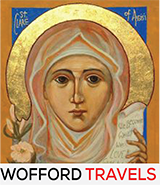Wofford Travels – 2018-09-27 Italy
Our next adventure in Italy was to be a visit to the iconic…Pompeii…a whole day, of course. On this occasion Tom and I would be on our own. Some in our group had been there before. One couple went to Capri and the other couple and 2 sisters went to visit an area where their relatives used to live in Progida.
We left our hotel at 11:30 and caught the metro for our 12:50 Train (Circumvesuviana) to Pompeii. When we arrived we had a decision to make: purchase an audio/not purchase an audio. We went with the former…at 6,50 Euros each, we felt it would be worth it. We didn’t know that we would have to relinquish something important, like a credit card. Seems we were getting a smartphone ($200 a pop). With a big gulp, we moved forward.
Now a little about Pompeii. What is it exactly? Well, after 800 years of inactivity, Vesuvious decided to erupt. The eruption produced such a column of smoke and dust that the sky fell dark for 3 days. Ash and pumice (known as lapilli) fell all around the volcano and in a single day the houses in cities like Pompeii and Herculaneum were submerged up to their roofs.
Pompeii had 15,000 inhabitants and few escaped. All activity taking place that day became frozen in time and remained so for 1,000 years. Initially, some returned to recover precious objects, bronzes and marble. The general appearance of Pompeii was still recognizable and the tile roofs juted out from the dentritus. Only the areas of large public buildings, such as the forum, were plundered.
in 1748 excavations began in Pompeii as a result of similar activity in Herculaneum 10 years earlier, which caused great excitement in the Kingdom of Naples and throughout Europe. People were aware of another site affected by the eruption, but the name of the city was yet a mystery.
Just so you can keep up with the following, you need to be aware that a hectare is 2.471 acres. For simplicity, we will round it off to 2.5 acres. Pompeii is approximately 44 hectares, or 165 acres of which 110 have been brought to light. So, two thirds of the city has been revealed while one third still remains to be discovered. However, due to the issue with erosion from the elements, the decision was made not to continue the excavations and focus on specific points to clarify the function and history of individual monuments.
A brief history. Pompeii was founded in the 6th century BC. It was made up of small communities that had settled in the Sarno Valley. To keep up with other Greek and Etruscan cities, Pompeii had to be organized in a more structured way than small rural villages. By this time, Pompeii had walls and religious sites (Temples of Apollo and Athena).
Although the city originated as an indigenous local settlement (inhabited by the Oscans who spoke an Indo-European language) archeological evidence shows that there was contact with the Greeks and the Etruscans.
In the 5th century, the city was occupied by the Samnites. It continued to flourish, even after its first clash with the Romans, due to its river port. But, it’s “golden age” was during the 2nd century BC when many of the magnificent houses were built. After a social war between Rome and the Italic peoples, (91-89 BC), the dictator, Sulla, founded a colony at Pompeii (80 BC). Many old Samnite families disappeared and the city was populated with Roman veterans who began acquiring some of the buildings.
it’s amazing that the public is “allowed” to walk through an excavation. But, it appears that it would be an ill-afforded luxury for this not to occur. So, the public benefits. And we certainly did. I was impressed seeing how the city was laid out. It could have been a small town anywhere with apartments or townhouses side by side. The small and large theaters accommodated many for the local spectacles. Impressive too was the level of hygiene with the street drainage system and public baths. Of course, one could go on and on about the artwork with frescoes and mosaic tiles…much of which can be viewed at the museums discussed earlier.
We made good use of the day. Then it was time to return. The train, fortunately, was far less crowded. In Naples we began looking for another “local-type” restaurant…and who did we run into, but our group as we walked by our hotel?! So, we decided on La Tratoria Concetta, Cucina Tipica Napolitana. We are thoroughly enjoying the Neapolitan cuisine. A short walk afterwards, and then it was time to retire for the night.
Tita
